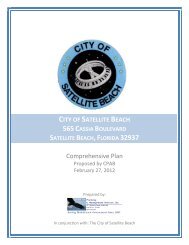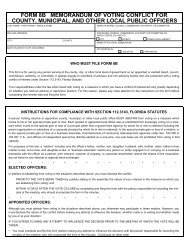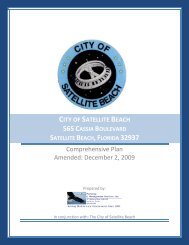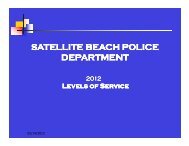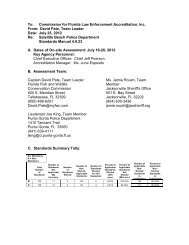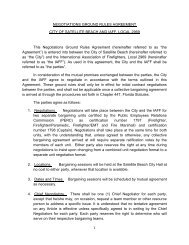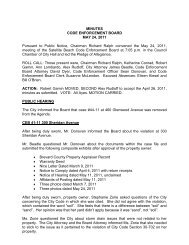Supporting Documents (Data and Analysis) - Satellite Beach
Supporting Documents (Data and Analysis) - Satellite Beach
Supporting Documents (Data and Analysis) - Satellite Beach
You also want an ePaper? Increase the reach of your titles
YUMPU automatically turns print PDFs into web optimized ePapers that Google loves.
Melbourne's water sources face three hazards. Lake Washington, like other lakes along the St. Johns<br />
River, contains a substantial growth of hydrilla, a fast-growing exotic aquatic plant. Unless<br />
controlled, hydrilla can degrade water quality due to decay, <strong>and</strong> it can clog water intake structures.<br />
Thus, Melbourne must continue a chemical treatment program to keep the hydrilla in check. Second,<br />
as a rain-fed, surface water supply, Lake Washington is subject to drought. This condition is<br />
exacerbated by a State m<strong>and</strong>ate that the St. Johns River Water Management District, in its role of<br />
protecting aquatic habitat along the river, establish minimum levels <strong>and</strong> flows to be maintained in the<br />
River. This will limit the amount of water which can be withdrawn during droughts, regardless of<br />
whether there is water in the lake to be withdrawn. Third, removing dissolved salts, as such, from<br />
water is an energy-intensive process, whether the process is reverse osmosis, distillation, or other<br />
means. As such, the cost of water from the Floridan Aquifer is highly dependent on the cost of the<br />
electrical energy required to operate the system.<br />
Water Conservation<br />
The City adopted an Emergency Water Conservation Ordinance in 1982 which sets forth m<strong>and</strong>atory<br />
requirements for City businesses <strong>and</strong> residents <strong>and</strong> penalties for violations of various specified<br />
measures aimed at reducing water usage in accordance with restrictions of the St. Johns Water<br />
Management District.<br />
Water Quality Management<br />
The City has come to realize that water management is a central factor in sustaining the quality of<br />
life to which its residents have become accustomed. The City's location on a coastal isl<strong>and</strong> dictates<br />
that the quality of water in local marine, estuarine, <strong>and</strong> freshwater habitats, as well as subsurface<br />
aquifers, must be maintained or improved to permit continued use for potable water, irrigation,<br />
recreation, <strong>and</strong> habitat maintenance. As such, potable water, sanitary sewer, stormwater<br />
management, <strong>and</strong> aquifer recharge are not discrete areas of concern, but represent different facets of<br />
one issue: water quality.<br />
Reuse of wastewater treatment plant effluent for irrigation is a trend which the City believes should<br />
exp<strong>and</strong> to address all venues in which water is managed. It has made a start in employing best<br />
management practices for storm water which: reduce local flooding, recharge the surficial aquifer,<br />
<strong>and</strong> reduce the quantity of runoff discharged into the Indian River Lagoon. Similar techniques can<br />
be used to eliminate runoff discharges into the Atlantic Ocean. In addition, the approximately 800<br />
million gallons of rainfall which are discharged annually from the City's stormwater outfalls into the<br />
brackish Banana River represent a potential source of supply for the approximately 300 million<br />
gallons of potable water consumed in the City each year - water withdrawn from the St. Johns River<br />
<strong>and</strong> the Floridan Aquifer. In these ways, wastewater plant effluent or stormwater runoff which causes<br />
or contributes to a problem now can be used beneficially.<br />
Infrastructure Element<br />
<strong>Data</strong> <strong>and</strong> <strong>Analysis</strong> 4-13



